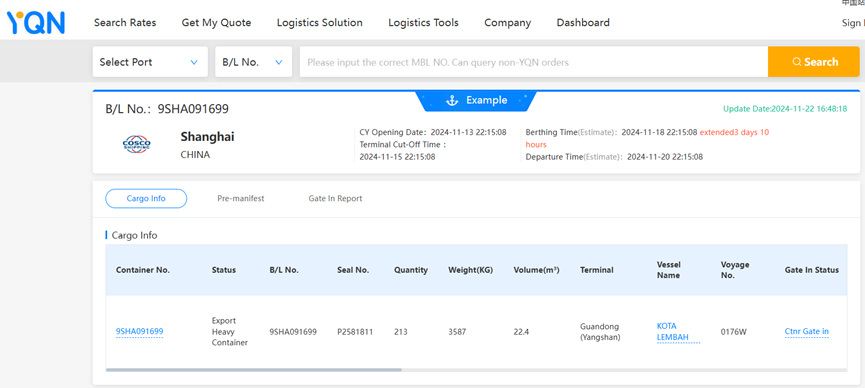FCL Autoparts Shipping: Money-saving Tips You Must Know
YQN Operation Team | Nov 22, 2024
When you think about shipping auto parts to other countries, logistics cost is a big deal. Usually if your shipment is a big amount or super heavy, you should choose sea freight rather than air or express.
Using FCL shipping when shipping autoparts globally can usually help you save money. Why? Because it’s more cost-effective than LCL (less than container load). In this article, YQN will show you how to calculate FCL autoparts shipping. So, if you're looking to cut down on autoparts global shipping expenses, please keep reading.
Understanding FCL Autoparts Shipping
FCL (Full Container Load) shipping means you fill an entire container with your goods, such as engine parts, brake pad, or gearbox, etc. Rather than sharing the container, you pay for the entire container, ensuring that only your items are inside. FCL shipping is a reliable choice for sea transportation, and is common for shipping autoparts.
FCL Shipping Freight Calculator
As global digital logistics expert, YQN provide you with free FCL shipping freight calculator. You can compare sea freaight rates for FCL autoparts shipping offered by all the top liners and you can search freight rates for different shipping routes just by one click.
Just put your POL, POD and commodity type, container size and quantity, estimated time of departure, then click “search” and you will find all the shipping options. For example, if you put POL as shanghai and set POL as Los Angeles, you will see all the FCL shipping rates provided by different carriers.
If you click view, then you can check the FCL shipping cost details including ocean freight and POL surcharge including documentation fee, EIR, booking fee, THC. The below is an example if you choose HMM for this case.

Besides those fees, you also need to be careful with other added fees which may influence the total cost of your FCL autoparts shipping.
- AMS fee: Fee for submitting the Automated Manifest System (AMS) documentation.
- ISPS fee: Fee related to compliance with the International Ship and Port Facility Security code.
- Demurrage fee: Different carriers offer varying free time allowances. If your shipments exceed this free time at the port of discharge (POD), they will incur a demurrage fee.
For more details, please contact info@yqn.com.
FCL Autoparts Shipping: Money-saving Tips
When you dive into FCL autoparts shipping, understanding the cost factors is crucial. Let's break down what you need to know.
1. Container Type and Size: Choosing the right size containers may be important before shipping. Usually you need to take cargo weight limit into consideration.For example, if you choose 20' GP, then the maximum weight limit is 19 tons; overweight fees are charged progressively. And for 40GP, different ports have various cargo weight limits. For more information, welcome to contact info@yqn.com.
2. Shipping Routes: The shipping routes can influence costs too. Some routes are transshipment and some are direct shipment, they may have different transit time and different rates.
You can use YQN’s free logistics tool ——Vessel Schedule to search the shipping routes options.
3. Package: Proper packaging is vital in FCL autoparts shipping. You can ask your freight forwarder to use durable packaging materials such as wooden crates, cardboard boxes during packing or use foam, bubble wrap, or other filling materials to prevent parts from moving and colliding during transit.
Tips
- Label Packages Clearly: Ensure that all packages are clearly labeled with handling instructions to minimize damage during loading and unloading.
- Conduct a Packaging Review: Before shipping, review packaging methods to ensure they meet international shipping standards.
4. Tariff and tax: Be aware of the tariffs and taxes applicable to your automotive parts in the importing country. These can vary significantly based on product classification and origin.
Tips
- Check HS Code: Utilize an HS code tool or consult with your freight forwarder to accurately identify your commodity type. This will enable you to verify the specific taxes and tariffs applicable to your shipment.
- Consult Trade Regulations and Duty Drawback Programs: Stay updated on changes in trade regulations and tariff rates that may affect shipping costs. Also, explore duty drawback programs to reclaim duties paid on imported goods under certain conditions.
5. Port Status: If there are strikes by dockworkers at the destination port, terrorist attacks, extreme weather conditions, or other force majeure events such as vessel explosions, shipping costs typically will increase. In such cases, shipping companies may impose additional charges, like port congestion surcharge, etc.
Tips:
- Monitor Port Conditions Regularly: Use YQN’s logistics tool——Port Status, and you can estimate if there’s congestions in your destination port.
- Have Contingency Plans: Develop contingency plans for alternative ports or routes in case of significant disruptions at primary ports.
Conclusion:
By choosing FCL auotoparts shipping, you can enjoy faster transit times and reduced risks of damage compared to LCL. This method proves more economical per unit, making it a smart choice for businesses aiming to cut autoparts shipping costs. In this article we discussed about how to calculate and tips to save on FCL autopaets shipping.
If you have any more questions about FCL autoparts shipping, welcome to contact info@yqn.com.















